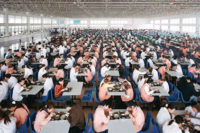And with good reason. Worldwide oil consumption will increase by 1.3 million barrels per day (b/d) this year and by 1.5 million b/d in 2013, with the higher demand met by increased production both from the Organization of Petroleum Exporting Countries and from non-OPEC producers, the U.S. Energy Information Administration (EIA) said in its latest Short-Term Energy Outlook.
Absent a significant oil-supply disruption, EIA expects the recent tightening of world oil markets to moderate in 2012 and to resume in 2013.
U.S. oil consumption is forecast to average 18.96 million b/d this year and 19.01 million b/d in 2013 vs. 18.87 million b/d in 2011.
EIA forecasts that U.S. crude oil production will average 5.74 million b/d this year, increasing by 170,000 b/d from 2011, and will climb by a further 80,000 b/d in 2013. Continued increases in Lower 48 onshore production of 270,000 b/d this year and 110,000 b/d in 2013 will overshadow declines of about 30,000 b/d in Alaskan output each year as well as a decline of 80,000 b/d in Gulf of Mexico production in 2012.
The U.S. will continue to be a net product exporter through the forecast horizon, EIA said, with net product exports averaging 310,000 b/d in 2012 and 290,000 b/d in 2013. For the first time since 1949, the U.S. last year was a net exporter of refined petroleum products, with gross product exports averaging 380,000 b/d more than gross product imports.
Of course uncertainties could push oil prices higher or lower than projected, EIA warned. Should a significant oil supply disruption occur, OPEC members do not increase production, or projected non-OPEC projects come online more slowly than expected, oil prices could be much higher. And if the pace of global economic growth fails to accelerate in OECD countries or if economic growth slows in non-OECD countries, then reduced demand could lower prices.
American renaissance
The spread of innovative drilling techniques combined with high oil prices have caused a renaissance in American oil exploration and production. The boom has been confined in large part to traditional oil-and-gas states like Texas and North Dakota, but other states are now enjoying their own expansions thanks to oil and gas development.
Workers naturally benefit from increasing oil investments, but they must deal with a high degree of mobility and a tolerance for isolation.
“Working in the oil industry can be exhausting, risky and lonely,” one observer declares. “But for these people, the high pay — often in the six-figures — and the thrill of chasing booms across the country is worth it.”
Back on top
The United States is seeing a dramatic surge in oil and gas production and could overtake the world’s biggest producers — Russia and Saudi Arabia — in another decade, a U.S. official recently said.
“Some of the numbers are eye-popping,” Daniel Sullivan, commissioner in Alaska’s Department of Natural Resources, told a panel of experts at the International Economic Forum of the Americas in Montreal.
In the last quarter, the United States produced 6 million barrels of conventional and unconventional oil a day, he said, adding: “We haven’t done that in 15 years.”
Since 2008, the United States has added 1.6 million barrels of additional oil, and in 2011, it registered the largest increase in oil production of any country outside of OPEC, he told hundreds of
participants.
These figures compare with a daily output in March of about 9.923 million barrels a day by Saudi Arabia — the largest producer of the OPEC nations — and 9.920 million by Russia, according to the industry data compiler Joint Organizations Data Initiative.
Sullivan said the respected consultancy PFC Energy estimates that by 2020, “the U.S. could be the largest hydrocarbon producer — that’s oil and gas — in the world, overtaking Russia and Saudi Arabia.”
In Alaska alone, the potential off the coast is viewed as the largest of any country, about 40 billion barrels in conventional oil, according to the U.S. Geological Survey.
Drilling boom
After declining to levels not seen since the 1940s, U.S. crude and natural gas production began rising again in 2009.
Drilling rigs have rushed into America’s oil and gas fields, suggesting a surge in domestic crude and gas production, The number of rigs just in U.S. oil fields has more than quadrupled in the past three years to 1,272, according to the Baker Hughes rig count.
Including those in natural
gas fields, the United States now has more rigs at work than the entire rest of the world combined — and by a wide margin: 1,994
versus 1,171.
The United States has more rigs drilling for oil and gas than the entire world combined (save for Canada).
Because of the drilling boom, the U.S. Energy Information Administration increased its oil production forecast for 2025 to 6.4 million barrels, up from its previous estimate of 6 million barrels.
Job boom = PPE prospects
Oil and gas extraction industries are in the midst of a remarkable jobs surge, as The New York Times recently detailed.
… [Oil] and gas extraction alone created 150,000 jobs last year — about 9 percent of all new jobs created in 2011, according to a new study from the World Economic Forum, though the industry accounts for only about 5.2 percent of total employment.
Looking more closely at Bureau of Labor Statistics data, virtually all parts of the oil and gas industry have seen job growth since the recession ended. Pipeline employment has risen 4 percent since June 2009. Oil and gas extraction has seen job growth of 18 percent. Employment in support activities for mining — like surveyors for drilling sites — has jumped 41 percent. During the same time period, total employment has increased just 2.1 percent.
While much of the rest of the economy has been stagnant (or declining), oil and gas has expanded rapidly in the last few years. And it goes back further than 2009.
Nine oil and gas, pipeline, and related construction industries, is a sector that had 30% more jobs in 2011 than in 2005, according to EMSI. Over the same time, national employment has shrunk 2%. This includes 62% growth for support activities for oil and gas operations and 35% growth for crude petroleum and natural gas extraction.
These impressive job numbers don’t include self-employed workers or proprietors.
Safety in the fields
During 2003-2007, the annual fatality rate in the oil and gas extraction industry was 30 per 100,000 workers, nearly eight times higher than the rate for all industries.
While many workers in this industry are killed in motor vehicle incidents, the second most common fatal event is contact injuries; workers being struck by, entangled, or crushed by tools, machinery or other objects. These types of injuries are often related to the machinery involved in drilling and workover operations.
Falls are one of the most common fatal events in the U.S. oil and gas extraction industry. The frequent need to work at elevations and the misuse or non-use of fall protection systems makes fall injuries a significant hazard. The workers employed by drilling contractors and well servicing companies (two-thirds of the workforce) spend much of their time working at elevations.
The industry realizes the importance of reducing the severity and frequency of onsite worker injuries without reducing work efficiency, introducing other injury hazards, placing an undue financial burden on the company, or requiring numerous additional skilled or technical staff at the rig site.
In addition, a diverse variety and large quantity of chemicals and mineral products are used every day by oil and gas extraction workers. While there has been ongoing and significant research on safety aspects (fatalities, causes of injuries, etc.) of the profession, the same cannot be stated for the occupational health (workplace health issues compared to workplace safety) aspects of the profession. There is little, existing information regarding occupational health risks for chemical and mineral exposures to workers in the extraction and production industry.
As part of the NIOSH Field Effort to Assess Chemical Exposure Risks to Oil and Gas Workers, NIOSH will partner with industry to better understand occupational exposures and possible health risks to workers by investigating the variety and magnitude of chemical exposure risks and routes of exposures that may be hazardous to workers. To determine the degree or absence of health risks, NIOSH researchers will conduct field-based exposure assessment studies to identify, characterize, and (if needed) control workplace chemical exposures
Regulators respond
Safety and health pros are among the few people in the U.S. who know anything about the Federal Chemical Safety Board. It’s a small agency with a big mission: preventing oil refinery and chemical plant explosions, fires and toxic releases that can harm people and the environment and disrupt fuel supplies. It is modeled after the National Transportation Safety Board, an independent agency that investigates airplane, ship and train crashes and makes safety recommendations but has no power to penalize.
The CSB can set no new standards. It can, and does, though argue for new standards. The CSB is aggressive in its outreach to news media and has been vocal in sharing its initial findings with the media and public.
But with no regulatory powers and a small staff and budget, the question remains whether the board has made refineries safer in the 14 years since it was funded — and some 13 years after it conducted one of its first root cause investigations, at the Tosco refinery north of Concord in 1999 that killed four workers.
In its 14 years, the board has deployed to 100 major fires or accidents — including the 2011 Deepwater Horizon explosion in the Gulf of Mexico and 2005 Texas refinery explosion that killed 15 workers — and issued 70 reports, safety bulletins and videos.
U.S. oil refiners say safety is a top priority in their highly regulated industry. The industry has had a 40 percent decrease in injuries since 2003, according to the American Petroleum Institute.
OSHA enforcement
Three Permian Basin (Texas) companies have been recently cited by OSHA after two workers died in separate accidents and four were injured in a flash fire.
A flash fire that occurred at an Elite Pipeline Services Inc. Odessa location will end up costing the company $25,200, according to documents acquired from OSHA.
The employees were not properly equipped or trained for the hazards of their work and were not notified of the possible hazards at the McAfee Pump Station before they began the work, according to the OSHA complaint, which lists six specific violations.
Two of the employees were transported to burn centers for the burns they suffered and one was treated locally.
The first employee suffered second- and third-degree burns on more than 60 percent of his body, and a second employee received the same severity of burns on his arm and neck.
A third employee suffered second-degree burns to both arms and a fourth employee received a first-degree burn on his forearm.
According to the OSHA documents, all four employees were standing around the valve when the fire occurred and burned an area of about 40 feet in diameter.
“The severity of the burns could have been fatal to any of the crew members,” the OSHA documents stated.
Documents responding to the allegations and citations show that Elite Pipeline Services Inc. vowed to assess work sites before employees began work on the sites. It also claimed it has begun to use flame-resistant clothing.
A rig in Mentone operated by Reeco Well Services was found to be in violation during a June 1 inspection, which OSHA investigators reported that procedures such as locking the draw works brake system were not implemented, exposing employees to hazards.
The company was fined $2,800 for the violation.
Although not mentioned in the report, an employee was killed May 31 in an accident after being struck on the back by a block while working on the floor, according to the OSHA weekly fatality reports on the department’s website.
A Great White Pressure Pumping site located in Garden City also was cited during an inspection for not inspecting equipment.
During a Feb. 7 inspection, investigators noted that a fracking iron in use was not inspected and pressure tested, swivel joints were not secured, employees were not provided communication devices during setup and use of high-pressure equipment, among other violations.
The company was fined $7,000 for the violation.
A 51-year-old Harlingen man died Feb. 7 at an oil drilling site 11 miles southwest of Garden City, Glasscock County’s Sheriff said.
Noe Cabriales, working for Great White Energy Services, died after Cabriales took the force of a line that burst. Cabriales was pronounced dead. His death also was not mentioned in the reports sent by OSHA.




